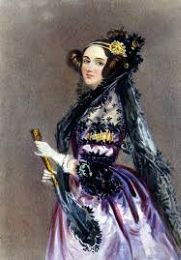

Ada was the daughter of romantic poet, Lord Byron, and his wife, Anna Isabella-Byron. Lady Byron raised Ada to be a mathematician and a scientist. Ada received an excellent education: she was tutored in mathematics by Mary Somerville, and by logician and mathematician Augustus De Morgan.
Her mathematical talent shone through in her early life, and her skills and interest in machines lead to a working relationship with Charles Babbage. Babbage was the inventor of the “Analytical Engine”, a complicated device that was never actually created, but resembled the elements of a modern computer. As a result of her work on the project, Ada is often referred to as the “world’s first computer programmer”. It was Ada’s notes on the Analytical Engine that Alan Turing used as a form of inspiration for his work on the first modern computer in the 1940s.
Ada’s health, which was poor on and off throughout her life, declined further after 1843, limiting her ability to practice mathematics. She died on November 27, 1852, probably of uterine cancer. At her request, she was buried next to her father. Her work remained relatively obscure until 1953, when Bertram V. Bowden compiled Faster than Thought, a history of computers that mentioned Ada’s work and called her a “prophet.”
What we now know about designing and programming computers may not be directly traceable to Babbage and Ada, but they can claim precedence for many of these concepts. And Ada in particular has become a figure whose life and work still stir the imagination of many computer scientists today.